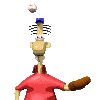Coaching Tips
Subscribe to our Newsletter10 Health Tips a Youth Baseball Coach Should Know

(provided by Temple University Hospital)
If you're a Little League coach there are 10 tips you should know to help keep your players healthy.
"The number one tip coaches should remember is that children are not miniature adults and shouldn't be treated as such," says Jim Rogers, a certified athletic trainer in Temple University Hospital's sports Medicine Center.
"This may seem obvious, but many adults don't realize children's bodies can't take the same amount of physical stress adult bodies can take. That's because children are still growing and therefore are more susceptible to injury."
Rogers offers coaches these other tips to prevent injury:
Stretching the muscles related to the activity is very important. For example, if a child is pitching, he should concentrate on stretching his arm and back muscles. If a child is catching, the focus should be on the legs and back.
A good warm-tip is just as important as stretching. A warm-up can involve light calisthenics or a short jog. This helps raise the core body temperature and prepares all the body's muscles for physical activity.
Children should not be encouraged to "play through pain." Pain is a warning sign of injury. Ignoring it can lead to greater injury.
Swelling with pain and limitation of motion are two signs that are especially significant in children -- don't ignore them. They may mean the child has a more serious injury than initially suspected.
Rest is by far the most powerful therapy in youth sports injuries. Nothing helps an injury heal faster than rest.
Children who play on more than one team are especially at risk for overuse injuries. Overuse injuries are caused by repetitive stress put on the same part of the body over and over again.
Injuries that look like sprains in adults can be fractures in children. Children are more susceptible to fractures, because their bones are still growing.
Children's growth spurts can make for increased risk of injury. A particularly sensitive area in a child's body during a growth spurt is the growth plate -- the area of growth in the bone. Growth plates are weak spots in a child's body and can be the source of injury if the child is pushed beyond his limit athletically.
Ice is a universal first-aid treatment for minor sports injuries. Regular ice packs -- not chemical packs -- should be available at all games and practices. Ice controls the pain and swelling caused by common injuries such as sprains, strains and contusions.
ANTICPATE THE BALL

(provided by Doug Barton)
When playing defense expect EVERY ball to come to you. Before EVERY pitch, think about what'll you do with the ball if it's hit to you. Also, think about what you'll do if the ball is hit to the other 8 players.
BATTING TIP

(provided by Lenny Carroll)
One of the hardest things about batting is keeping your eye on the ball .Try getting 2 or 3 1inch diameter rods (wood if possible) the length of a bat, and a bucket of practice golf balls. Sit next to the batter and toss the balls underhanded to the batter and then overhand. Theory, if the batter can learn to pick up something the size of a golf ball and hit it with a one inch bat just think what he/she can do with a reg. bat and ball.
Coil, Pivet, Swing
(provided by Dave Gwiazdon)
I attended a coaching clinic several years ago, which was given by a couple of former big league ballplayers. One of the catch phrases they discussed had to do with hitting for power. So many kids swing with just their arms and this has really helped to remind a player to use their body. It's nothing new, but I use it quite often and it helps.
Their phrase was,"coil, pivet, swing". And reminding a player before an at-bat really helps to insure they remember to use their hips. A lot of kids swing first and then rotate their body. If they put that in the right order, they are amazed at how much stronger they hit the ball.
There's nothing better than seeing one of my kids with that surprised look on their face when all of a sudden they hit the ball with power!
Tee-Ball Baserunning Drill

(provided by Jay Fernandez)
One of the things we noticed on the first day of Tee-Ball practice, was that the kids needed to know how to run the bases. To help them out, we came up with a simple drill which teaches them the correct direction to run.
Have the kids line up behind home plate
Have each player throw a ball (don't let them hit yet) into the field and then run completely around the basepath.
Do this before the first few practices and the kids will run in the correct direction each time.
After they have this down, give them a bat and let them hit the ball. (Try not to do this until they have the correct direction down first -- this way they don't get too distracted!)
After they have mastered the fine art of running the bases in the correct direction, you can expand this drill by randomly yelling Single, Double, Triple and Home Run. Have the kids run the correct number of bases depending on which hit you yell out!
They had a ball doing this drill and wanted to do it each week even after they all knew how to run the bases.




